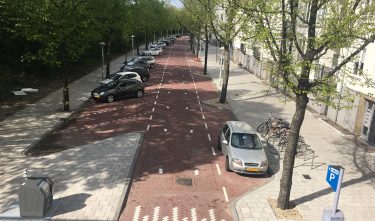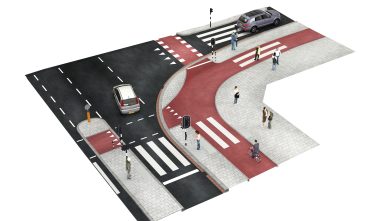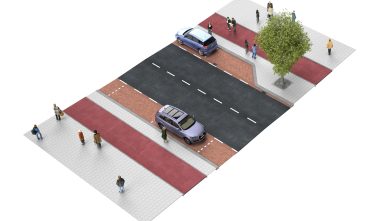Who are the winners of Dutch Design Awards? What drives them and what is their vision of design and good commissioning? This time in the Winner’s Portrait series is Heiko Miskotte, chief designer of public spaces at the Gemeente Amsterdam. He is one of the project leaders of the Puccinimethode. A ‘design system’ for the physical urban layout of Amsterdam. This won the municipality a Dutch Design Award in the category Best Commissioning.
 1
1
Why the name Puccinimethode?
‘When the project had just started in 2001, several council officials gathered together for a meeting. It was too early for ‘bitterballen’, so we got bonbons from Chocolatier Puccini opposite the city hall. One of those present commented: ‘If the quality of the public spaces in Amsterdam was as good as these bonbons, we would have achieved our goal.’ The project needed a promotional name, and so it became the Puccinimethode. I initially assumed that the name would soon die out, but 15 years later it has become a household name.’
The Dutch Design Awards jury praised in particular the extremely compliant way in which it utilizes design management. Was that a conscious decision?
‘Great that the jury calls it that, but we never said: ‘we’re going to get started and start using strategic design management’. This is ultimately what it is, but it gradually became so as the project continued to grow. The Puccinimethode started modestly. The subtitle of the project was ‘Recommendations for improving the implementation quality of public spaces’. And it was needed. Amsterdam has invested a great deal in its public spaces over the past 25 years, but there was a lot of fragmentation. Each of the – at the time – 14 city districts had its own manual and policy frameworks. Qualitatively good, but there was no central vision and too little mutual coordination between all involved projects, services and city districts. There was a widely supported desire to organise things centrally.’
 2
2
 3
3
How did you approach this and what role did design play?
‘It has been a long process that required structural changes in working methods and organisation. We knew that it would only work if everyone subscribed to the problem of fragmentation of the public spaces. Design and design management have been essential in creating support and context. The Puccinimethode is very consciously a visual manual. You can get people on board faster if they can see why one idea works better than another. This approach also proved its worth when the method was rolled out. Thousands of people work in the spatial sector at the Cluster Public Space and Economy. Many of these people work with the Puccinimethode. It is primarily the convincing images that ensure everyone appreciates the value of the method and understands what the intention is.’
How do you organise such collaboration between so many different areas of policy?
‘The Puccinimethode affects many different interests and areas of policy. As such, we want a traditional, sustainable layout that takes into account climate resilience and circular use of materials. It must be safe for traffic and easily accessible. It should be easy to purchase and manage materials. And all this must fit within budget, without compromising on quality. With a clear organisational structure – from design to implementation and management – we try to keep a grip on it all. In addition, joint responsibility and collaboration are essential. You have to keep the dialogue open and respect each other’s professional expertise. Sometimes sustainability wins over budget, and sometimes the aesthetic wishes have to make place for traffic safety.’
— 'Design and design management have been essential in creating support and context for the Puccinimethode.' - Heiko
As a municipality, how do you manage the proper implementation of the method?
‘It has taken over fifteen years for the Puccinimethode to develop the shape it now has. We now know very well what does and does not fit within the method and have a clear idea of the intended quality. This means that we can and must be strict in terms of advice and assessment of projects. We are sometimes even jokingly called ‘The Puccini police’. And a framework is also needed if you want to create a consistent street scene. Of course, there is also space for customisation, creativity and common sense. The Puccinimethode is an instrument, not a goal in its own right. It is a dynamic process whereby a balance must constantly be sought between standardisation and innovation.’
Creating the right framework for adequate implementation is a basic condition for good and careful commissioning. What is your advice on this for other municipalities?
‘I think it is mainly about a shared, long-term vision of the desired quality. And taking the time to shape this vision. Changes cost time and must be supported by the whole chain. So, be active, visible and approachable. Stay flexible and make sure that good, new developments are applied. Above all, you should have the courage to stand up for the essence of your vision, even when faced with resistance or in difficult times. If you no longer believe in it yourself, it will irrevocably fall apart.’
In your opinion, when is urban design a success?
‘When it embodies simplicity and quality, and the users can move freely and logically through the public space. A balance between functionality, sustainability and aesthetics. Thanks to the Puccinimethode, we are seeing more and more logical, quiet streets in Amsterdam. For the neutral onlooker, the overall appearance is right without it feeling over-designed.’
The Puccinimethode
From curb to drain and from square to park. The Puccinimethode defines how the public spaces of Amsterdam are designed. It specifies all kinds of details. The choice of materials for every kind of tile, brick and gully is defined. It also details specifications for furniture, lighting and greenery. This system, consisting of a policy framework and two technical manuals, applies several standards to design the whole city with quality, sustainability and cohesion.